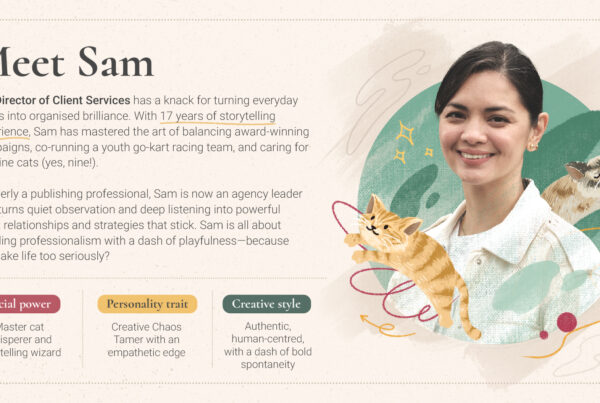
“It unites and tears us apart,” someone once said about the Vietnamese people’s relationship with pho.
You wouldn’t be faulted if you thought they were talking about marketers and strategy. That’s because few terms in content marketing are as sexy yet fuzzy as “strategy”.
Everyone’s got their own take.
Everyone thinks their take is right.
Why strategy is like a bowl of pho
Nine people. Nine bowls of pho.
During our recent company retreat in Hanoi, our team crammed ourselves into a tiny noodle shop. The vendor served us steaming bowls of pho, each derived from the same huge pot.
Same broth, same ingredients.
But once we’d added garnishes, poured sauces, and adjusted the spice level, we each ended up with our own distinct bowl of pho.
Similarly, marketers in identical circumstances can come up with very different strategies.
Say, for example, a tech startup wants to enter the insurance industry. It must compete with legacy companies, meet regulations and standards, and build a network of partners and service providers. Its strengths are its technological talent and agile development culture.
Its three co-founders agree that they cannot beat the industry giants at their own game — they can’t scale rapidly and catch up with all the compliance and networks those companies have built over decades.
So they decide to challenge the rules of the game instead.
Each co-founder proposes a different path:
- Woo the audiences the giants have ignored. The startup will create insurance products for freelance professionals, remote companies, and senior citizens.
- Become an asset all the players want. Develop digital backend infrastructure and technology to run processes like risk management and claims assessment for large insurance companies.
- Change the playing field. Launch a digital platform that lets customers build their own insurance packages by combining benefits from different providers and foregoing features they don’t need.
The three co-founders started with the same context, strengths and constraints.
They ended up with three completely distinct strategies.
Just like the bowl of pho…
Why is ‘strategy’ so divisive?
So whose strategy is right?
Well… That’s the wrong question to ask.
Rather, it deals with the messy reality of market forces, unexpected events, customer preferences, talent, skill, and execution.
It’s not an insight you can pull from data alone, because data speaks of the past while strategy looks to the future.
It requires willingness to execute and test a theory in the real world, and the wisdom and agility to adapt to circumstances.
But in a culture marked by a fear of losing, an aversion to risk, and the constant need to save face, we can’t help but ask:
How do I know for sure my strategy will work?
Is this the right choice?
Here’s the thing: if your strategy is clearly the ‘correct’ answer, that doesn’t make it much of a decision.
And strategy is an act of choosing.
The next best thing we can do to satisfy our need for certainty — without creating rigidity — is to have a common understanding of what content strategy is, and share frameworks for developing it.
Even that is enough to stir arguments:
 To one marketer, content strategy might mean a framework supported by messaging pillars, built on the foundations of PR.
To one marketer, content strategy might mean a framework supported by messaging pillars, built on the foundations of PR. To another, it starts with SEO and a funnel.
To another, it starts with SEO and a funnel. Some want strategy to be a stroke of genius and a panacea for their marketing woes.
Some want strategy to be a stroke of genius and a panacea for their marketing woes. Still others believe it’s subservient to marketing campaigns and sales strategies.
Still others believe it’s subservient to marketing campaigns and sales strategies. Many treat it as an annual exercise.
Many treat it as an annual exercise.
These expectations reflect the reality that content marketing is not yet a mature field in Southeast Asia, as it relies heavily on concepts from other fields.
And content marketing here hasn’t evolved much beyond the basic concepts we learned from Content Marketing Institute and HubSpot 10 years ago.
But as more businesses aim to reach their audiences online, it’s time for us to find common ground and recognize content marketing as a legitimate field with its own terms and tools.
 So what is strategy, really?
So what is strategy, really?
Through years of theory and practice, we’ve come up with a strategy definition that’s as simple as it needs to be, but not simpler.
TL;DR: Strategy is what you choose to do now, out of two or more options, to influence the future.
Strategy is not:
![]() a plan
a plan
![]()
![]()
![]()
![]()
![]()
![]()
![]()
![]()
![]()
![]()
![]()
![]()
![]()
![]()
![]()
So ask instead:
- Which path can we reasonably pursue to make our desired impact? Why this path and not others?
- Is this strategy defensible?
- What does successful execution look like? What would have to be true for this to happen?
- What’s the worst that could happen?
The good news is that there are frameworks and thinking tools that we can use to answer those questions.
And you can adapt these frameworks and tools to work in your context.
Next week on Rise
One framework we can use for developing strategy is the strategy core.
The strategy core helps you determine your most crucial problem and the factors that would have the most impact on the outcome should you choose to leverage them.
It looks like this:


Next week we’ll talk more about the strategy core, along with three thinking tools to help you develop it.
D.I.Y.
Try crafting a strategy that’s the opposite of your current one. Is this opposite path defensible, or is it obviously a poor choice?
If it’s the latter, chances are your strategy isn’t completely one.
Consider different angles to re-developing your strategy:
- Maybe the problem you’re trying to solve isn’t pivotal enough.
- Maybe you lack leverage.
- Maybe you need to understand your constraints better.
Once you’ve arrived at answers, check again if your strategy (and its opposite course) is defensible or not.
Let’s raise the bar of content marketing in Southeast Asia
We hope you’re enjoying Rise and find this newsletter helpful.
And if you do, why not share it with a friend?
Thanks for reading!
![]()
![]()
Katrina
with help from Nikki, Sam, Mike and Daniel
Illustrations by Aldrin



